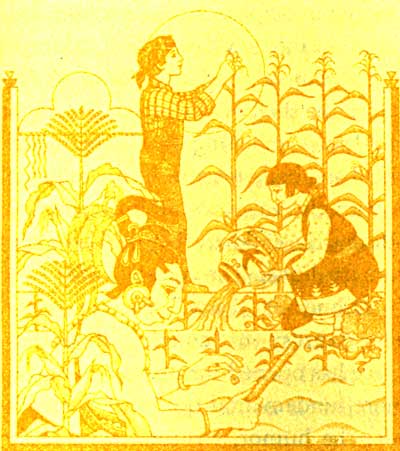
I dreamed that dream again, the scary one that comes down like a silent raptor in the late watches of the summer night, around the August full moon. I wake up in a cold sweat, pinned down by the talons of my summer nightmare. Alone and cut off, I am lost in a weed-free, vast modern cornfield, with no beginning or end. Dead Monarch butterflies litter the ground. Gigantic corn plants creak and sway high above me, heavy with their burden of flawless genetically-engineered corn. In this nightmare, I am a severed being, shrunken to a wizened mouse, sure that I will never escape this field of dreams.
Does upright sitting help in a moment like this? Oh, please! I wake up with a shudder of dread and go out instead to the pre-dawn garden, invoking the counsel of the ancient ones, the Three Sisters, Dio-He-Ko, or corn, beans, and squash, to bring me back to life from my Frankenfoods dream.
I am the eldest of three blood sisters. And we are a fierce kinship circle, so I have always loved planting the Three Sisters of the garden, “those who sustain us.” Grown together in Mesoamerican gardens since pre-Columbian times and earlier, these ancient ones were seen by the maidens of an Iroquois agricultural society as a three-in-one goddess, growing together as a community to nourish body, mind, and spirit. In our Zen gardens, corn, beans, and squash are the agricultural triple treasure of the empty field.
Corn, the queen of crops, or the “Old Woman Who Never Dies” in the Mandan and Hidatsu traditions, is a mystery, for unlike other crops the flowers and seed of corn are distinct, growing separately on the same plant. Also called Ta’a, “the seed of seeds,” corn expresses herself in many forms: dent, flint, flour, sweet, pop, or wax corn. Since her first appearance, the Old Woman Who Never Dies has stood among us as one of the three major cereal crops of the world.
Beans grow along with the Corn Mother. Originating between five and eight thousand years ago from Peru to Mexico, beans are an essential part of the New World diet. Indeed, bean images have appeared throughout the Americas in prehistoric art. Tiny bean figures with bowed legs hearken back to the old Inca empire, when beans were used as a means of communication. Long-distance runners carried colored bean seed along sophisticated roadways for hundreds of miles, carrying world news signified in a handful of beans. A primary source of protein for soil, plants, and humankind, beans twine up the stout stems of corn, their dry pods rattling in the summer wind.
Squash is the eldest of the triple treasure sisters, dating back nine thousand years to the scattered seed remains found in the prehistoric caves of the Tamulipas Mountains of Mexico. Sorted into four modern species that span the range from pumpkin to gourd to zucchini to warty hubbards, squash plants cover the ground with their succulent vines and fruit, protecting the earth at the base of their corn and bean sisters.
In our garden these Three Sisters grow together in a mighty jumble, as they have for millennia in the persistent cultures of the New World. My nightmare of monster corn fades back in the old presence of the intertwined sisters. In our summer garden a full stand of Rainbow Inca and Hopi blue corn reaches higher than any elephant’s eye. Nearby grow dun and chestnut speckled beans sent to us two years ago by children fleeing from their native Kosovo. The plan is that we will grow out these Kosovar beans in our garden and send the seed back again to the Balkans when it is safe to plant. I trust that the passel of North American kids who came to our garden last May to plant the Kosovar beans will make sure this happens, especially since they are the same children who also set out Cinderella pumpkins and Guatemalan blue squash in our Three Sister plot.
Why not dedicate a patch of your own garden, this year or next, to Dio-He-Ko? After all, corn, beans, and squash belong together; they are the true dispellers of the dream of a separate, severed self.
At the end of the growing season you can throw a triple-treasure party in the heart of your garden to celebrate the horticultural trinity of the Three Sisters. Invite those you love, your newest friends, and even a few enemies. Roast plump ears of open-pollinated corn over banked bonfire coals, make a marinated bean salad to share with your tribe, and bake some moist pumpkin bread as well. Stay up late. Tell stories of persistent culture until the last star sinks below the rim of the autumn sky, and taste the living truth of those who sustain us. ▼